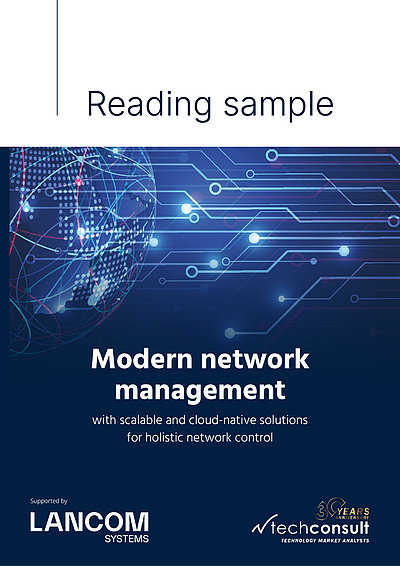The flexible assignment of roles in the LANCOM Management Cloud
Noticeably less workload with more efficiency and better results
If you could weigh the burden on the shoulders of a company's employees, the IT administrator would certainly be in the top 3: When all is working perfectly, this is of course taken for granted. If there are problems, complaints flood in from all sides; everyone who sits in front of a PC will be breathing down the neck of their contact in IT. Because this is usually the only person with access to the network, and it’s all on them. Things get really dramatic when the administrator is absent, maybe through illness, a Wi-Fi goes down, and an entire team suddenly can no longer work.
Modern cloud-controlled network management reduces the burden of sole responsibility and spreads it over several shoulders. Provided that a clear, well thought-out permissions management is used to regulate the access options for relevant personnel.
Is your company NIS2-compliant and digitally sovereign?
Take control of your network security and Digital Sovereignty. Security requirements are increasing: starting in 2024, the EU NIS2 directive will apply to more companies than ever before and mandate stricter measures for network and information security. Additionally, Digital Sovereignty is becoming an increasingly urgent issue in Europe. It’s worth checking whether your company needs to take action. We provide informational material and practical tips to help:
Learn more about NIS2 and Digital Sovereignty
The 6 user roles for projects of the LANCOM Management Cloud
The LANCOM Management Cloud offers eight defined user roles, two of which can be assigned at organizational level and six at project level, ranging from full access for the network administrator to network monitoring with no option for intervention. In between are practical gradations that allow, for example, the management of devices only, or a hotspot role for installing new components on-site and integrating them into the network with the help of a smartphone and the Rollout Assistant.
As a result, crisis scenarios such as a device failure can be immediately defused at any location by IT employees with the necessary rights. But that’s not all. Even in "normal" operations, managing roles and rights in this way is an immediate relief for resources in the IT department: It reduces the workload on valuable IT specialists, who can be deployed where their qualifications make the most valuable contribution to the company's goals. Furthermore: With the shortage of skilled workers that we see today, work can be outsourced to system vendors for supreme flexibility, from one minute to the next.
With the made-to-measure roles in the LANCOM Management Cloud, companies have everything they need to achieve better IT performance with fewer IT resources.
Modern network management
„Globalization, digitalization and the pandemic have shown companies that the technical prerequisites for a future-proof operation are not yet fully developed. Not only the number, but also the variation of the devices in the network has risen rapidly alone by the fact that a lot of employees have switched to working from home. [...] Today, a network architecture uses a large number of sensors, controllers, routers, switches and access points. In addition, the networking of different locations has become a significant factor in the efficient operation of the entire company due to globalization, internationalization and outsourcing as well as the integration of business areas. What is needed are network management solutions that intelligently organize, optimize and manage these components and enable the network to achieve a holistic security standard.“ – techconsult study from 2022
More time for true network management
A reasonable division of labor has one main purpose: everyone does what he or she does best. For example, optimizing network performance, monitoring network security, or expanding the IT infrastructure.
Want some inspiration? You're sure to find what you're looking for in our content hubs on network security and site networking, where you can read all about important criteria for network construction, as well as dangers and optimization options.
And if you would rather concentrate fully on network management for the time being, you can deepen your knowledge with our info papers, tech papers, and white papers, and you are sure to learn a lot more exciting things about the LANCOM Management Cloud on our info pages:
Infopaper: LMC User Roles and Rights
Infopaper: LMC (Public) Data Protection and Data Security
Infopaper: LMC – SIEM Integration Service
Techpaper: Concepts of the LANCOM Management Cloud (LMC)
Techpaper: LANCOM Management Cloud - Rollout
Techpaper: Cloud-managed Hotspot
Techpaper: Scheduled Events in the LMC
Whitepaper: LANCOM Cloud-managed hospital networks (SDN)
Whitepaper: Cloud Management and Software-defined Networking







